The
Land That Time Forgot (TLTTF) is the first of three
novellas written by Edgar Rice Burroughs (ERB), that comprise the Caspak
trilogy. One could make the argument that these books are novels, short
to be sure, but at an average of 125 pages in the small Ace format, I consider
them novellas or novelettes. But it should be considered that these were
meant to represent one book and as such they were published by McClurg
and Grosset & Dunlap in a 1924 hardcover. Whatever, they are damn good
reading!
http://www.erbzine.com/mag23/2306.html
It was first published in August of 1918 in "Blue
Book Magazine." No serialization, all in one issue.
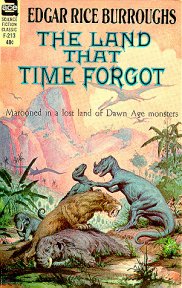 Roy
Krenkel, Jr. illustrates all three covers of the early Ace editions and
all are marvelous. The Land That Time Forgot features no scene from
the book but does capture the primitive and exotic atmosphere of Caspak.
We see a saber-tooth tiger crouched over and protecting its recent kill,
a baby mammoth. Its mother can be seen looking on helplessly in the background.
Behind the big cat, a T-Rex and allosaurus battle as two primitive warriors
scurry out of their way. A couple of pterodactyls soar above the nearby
jungle while mysterious hills rear up in the distance. This may well be
one of Krenkel's best covers of an Edgar Rice Burroughs book!
Roy
Krenkel, Jr. illustrates all three covers of the early Ace editions and
all are marvelous. The Land That Time Forgot features no scene from
the book but does capture the primitive and exotic atmosphere of Caspak.
We see a saber-tooth tiger crouched over and protecting its recent kill,
a baby mammoth. Its mother can be seen looking on helplessly in the background.
Behind the big cat, a T-Rex and allosaurus battle as two primitive warriors
scurry out of their way. A couple of pterodactyls soar above the nearby
jungle while mysterious hills rear up in the distance. This may well be
one of Krenkel's best covers of an Edgar Rice Burroughs book!
To be sure, the cover looks like something out of ERB's Pellucidar series,
where dinosaurs, cavemen and prehistoric beasts battle for mastery at the
Earth's Core. Well, maybe not the actual core, but 500 miles down ought
to be deep enough. But no, Caspak is not Pellucidar nor even related except
by the similarities in flora and fauna. Known to explorers as Caprona,
the large island was originally discovered by the Italian navigator Caproni
in 1721. Located in the South Pacific, bordering on the Antarctic Ocean,
Caproni could only observe the outlying cliffs that prevented any access
to the island proper. Soon, both the explorer's discovery and Caprona itself,
faded from the memory of man. Most men that is. The English tug First Mate,
Bradley, is aware of the legend which he relates to Bowen J. Tyler, Jr.,
upon their rediscovery of this vast island.
We are blessed by Krenkel with a frontispiece on the title page depicting
the U-33 approaching Caspak. Erroneously, a pterodactyl and palmed beaches
are shown. Neither was actually seen beyond the cliff-walls surrounding
the island. Though this scene never happened, it again captures the essence
of what Caprona is about.
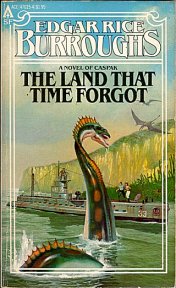 I
also possess a later edition of this book, by Ace as well. This version
was published in 1979, according to the cover art copyright. It also gives
the original Ace printing date of August 1970, not given in that small
Ace format. This version is in the traditional mass market paperback style,
with (surprisingly), 153 pages compared to 126. The aforementioned cover
art depicts a similar scene that Krenkel illustrates in his frontispiece.
The artist (Vicente Segrelles) is not credited, that going to Edgar Rice
Burroughs, Inc. Too bad as it is very well drawn, though in a crisper style
than Krenkel. As I look at it now, I believe I was in error by stating
that the scene depicted by Krenkel was on the U-33's approach to Caprona.
It could very well be taken from the submarine's journey up the river,
with the soaring cliffs viewed from inside Caspak.
I
also possess a later edition of this book, by Ace as well. This version
was published in 1979, according to the cover art copyright. It also gives
the original Ace printing date of August 1970, not given in that small
Ace format. This version is in the traditional mass market paperback style,
with (surprisingly), 153 pages compared to 126. The aforementioned cover
art depicts a similar scene that Krenkel illustrates in his frontispiece.
The artist (Vicente Segrelles) is not credited, that going to Edgar Rice
Burroughs, Inc. Too bad as it is very well drawn, though in a crisper style
than Krenkel. As I look at it now, I believe I was in error by stating
that the scene depicted by Krenkel was on the U-33's approach to Caprona.
It could very well be taken from the submarine's journey up the river,
with the soaring cliffs viewed from inside Caspak.
The blurb on the back cover contains a portion of Lin Carter's Foreword
(given completely within) and the following:
"A LOST WORLD: Over the centuries, men have sighted it, written of
it, dreamed of it--but no modern man has ever entered the hidden valley
of Caspak. For here dwell the creatures of nightmare: prehistoric monsters
from eons past, still battling with brutish ape-men for dominion of the
jungle."
"Into this land of savage terror comes American adventurer Bowen
Tyler and his crew. Here these modern men will meet unparalleled adventures
as the struggle to survive in THE LAND THAT TIME FORGOT."
I am fortunate to also have obtained the Bison Books/University of Nebraska
Press edition of The Land That Time Forgot in trilogy format. This
was printed in 1999 as a Commemorative Edition with an Introduction by
Mike Resnick. The Land That Time Forgot contains two original illustrations
by J. Allen St. John. The first is this book's frontispiece depicting a
T. Rex about to feast on the mammoth it had slain and two Pterodactyls
battling in the background. The second is the original version of Krenkel's
frontispiece and Vicente Segrelles' cover from the 1979 printing. Definitely
the best of a great lot! Sadly, a St. John illustration does not grace
the cover of this book. The jungle-dominated piece is credited to R. W.
Boeche. Nicely drawn, but no Krenkel or St. John!
The format is trade paperback and contains 140 pages.
The back cover contains the following:
"Set on the lost island of Caspak in the South Pacific,
this novel is a dazzling blend of imagination, daring adventure, and intriguing
scientific speculation."
"Hidden behind towering, impassable cliffs, Caspak will not
easily give ups its secrets. Unique and terrible animals and peoples inhabit
the island. Dinosaurs terrorize tropical jungles to the south, while menacing
wing humanoids dwell on cities on a large island to the north. Caught between
these threats are scattered groups of human beings. Despite their differences,
however, Caspak's animals and peoples are all connected in a mysterious
and marvelous way."
The back cover further states that "This commemorative edition features
the entire Caspak triloy in one volume, as intended by the author."
Mike Resnick's Introduction is seven pages long and begins with both
literary criticism of ERB's style as well as kudos. He then delves extensively
with events within the trilogy and analyzes them intensely. Again, with
both the positive and negatives. Interestingly, Resnick brings up one my
own questions concerning the tribes of Caspak, which I'll relate as the
subject comes up. He finishes with:
"He was the first, and he is still very readable and popular.
And what more need you ask of a pioneer? You're sitting here holding his
most imaginative book, so maybe it's time for me to vanish and for you
to enjoy your journey through The Land That Time Forgot."
It is Tyler who features most prominently in "TLTTF" while Bradley
has his turn in the third Caspak installment, Out of Time's Abyss.
As to the middle book, The People That Time Forgot, our hero is
not a part of the original expedition and will be introduced in due time.
I mentioned Pellucidar earlier and I acknowledge it to be my favorite
of ERB's series, though the adventures of Carson Napier on Amtor (Venus),
rank a close second. When I first read the Caspak books, I thought perhaps,
in my way to over eager imagination, that Caspak might be the South Polar
Opening to the inner world. After all, David Innes glimpsed the North Ploar
Opening from within Pellucidar, while Jason Gridley and company flew through
it from the surface world. It was theorized by Abner Perry that a similar
opening exists in Antarctica but Burroughs never explored that possibility
any further.
I discount my childhood hopes for two reasons. Though bordering on the
Antarctic Ocean, Caspak is not part of Antartica, never mind even close
to the South Pole. Secondly, though much of Pellucidar and Caspak is very
similar in terms of the animal and plant life found in both places, being
of many different ages from the Earth's dim past, the secret to evolution
on Caprona is vastly different from that followed by the inhabitants of
the inner world and indeed, the rest of the surface world. More on this
later.
The back cover to my small Ace edition is almost as exciting as the
Roy Krenkel front. Featuring the title in bold capitals and the T-Rex from
the front, the blurb captured my imagination at once and it goes thusly:
"Bowen Tyler's adventure began with a terror-haunted trip
as a captive in an enemy submarine. It ended on the rocky shores of a lost
world, an unmapped land forgotten by the rest of humanity, where the beasts
and beast-men of the Stone Age lived and fought as they had hundreds of
thousands of years ago."
"What was the secret of this mysterious continent, where time apparently
had stopped and where dinosaurs, saber-tooth tigers, and ape-men still
struggled for their lives with tooth and claw?"
"THE LAND THAT TIME FORGOT is an epic of imagination and science-fiction
adventure by the creator of TARZAN OF THE APES."
As if the covers weren't enough to get my imagination running wild, there
is a "Foreword" by none other than Linwood Vrooman Carter! It reads as
follows:
"Verne--Wells--and Burroughs, the three masters of the scientific
romance. Verne found drama and excitement in man's ingenuity in overcoming
the obstacles of hostile nature. Wells found his themes in the expanding
frontiers of scientific knowledge and in the hopes for a better future
world."
"Edgar Rice Burroughs summed up and absorbed these earlier writers.
Like Verne, he often wrote thrilling sagas of adventure and exploration.
Like Wells, he frequently exploited the new discoveries of science, in
his interplanetary romances."
"This book, The Land That Time Forgot, is one of his finest and most
exciting adventures. A colorful, fast-moving novel of high adventure, it
carries you from the submarine-infested oceans of World War I--to the primeval
jungles of Caspak, where men of today are pitted against the mighty monster-lizards
and bestial submen of forgotten ages."
"As you join the thrilling voyages of the U-33 into a lost world
of the earth's remotest dawn, as you accompany Bowen Tyler on his fantastic
journey through a savage world, you will find yourself lost in one of the
most enthralling and suspenseful romances ever written-an heroic, action-filled
saga worthy of comparison with Doyle's The Lost World or Haggard's King
Solomon's Mines."
--Lin Carter
Science-fiction critic
and Editor of Spectrum
As Forewords go, Carter wrote a superb one. I wonder that I should even
go on with my own thoughts. Well, I've come this far so I'll slog on and
do my best.
The first chapter begins with the finding of Tyler's manuscript, describing
his adventures in Caspak, enclosed within a thermos bottle. And this was
just off the coast of Cape Farewell in southern Greenland! The finder is
not named, though perhaps it is Burroughs himself. His last words before
Tyler's begin, are "In two minutes you will forget me." Indeed, we do but
he returns for an encore in The People That Time Forgot.
The first 52 pages of "TLTTF" are strictly of the high adventure
variety. The action takes place in 1916 when Germany announces that its
submarines will be attacking non-military ships of any country that are
headed for Allied ports. Bowen Tyler and Lys La Rue are both victims of
the sinking of their trans-Channel liner. Not satisfied with the ships
sinking, the Germans follow-up with shelling the survivors in their life
boats. Sheer barbarism, that!
The two are rescued by a passing British tug which in turn is attacked
by another (perhaps the same), German submarine. Through trickery and desperate
courage, the crew of the tug take possession of the sub and prisoners as
well. During the bitter battle for supreme cy, the tug's Skipper dies but
his First Mate, Bradley, survives. However, no allied ship or port will
accept that they are not German and so they are, almost comically, forced
to leave the English Channel and ultimately head south and cross over to
the Pacific Ocean by way of Tierra Del Fuego. Through treachery, and not
of the Germans, the U-33 has headed much further south than desired and
instead of Bora Bora, they sight Caprona and nearby icebergs as well.
Though these 52 pages are fraught-filled and make for some mighty good
page-turning reading, it is Capak that my heart yearns for and I can't
help but feel a little cheated that 52 of the 126 pages are used for the
stories' "set-up." Frustrating yes, but necessary as there is an array
of characters and each plays a significant role, near and in Caspak.
Running low on oil, food and water, Tyler and Bradley are desperate
to make land and Caprona provides their only opportunity of survival. Except
for one barren beach, they espy no place land as the steep and towering
cliffs enclose the entire island throughout its hundreds of miles of coastline.
The skeleton on an apeman is found on the beach, evidently having been
heaved down from the cliff top. This alone should have forewarned the crew
that Caprona's haven might be fraught with danger. Exotic vegetation is
briefly glimpsed atop the heights, but not clearly. Still, they have little
choice but to continue trying to seek egress and finally they do, through
a subterranean tunnel that leads from outside to a river that flows northward
through Caspak to its inland sea.
This river is chock full of prehistoric saurians which immediately attack
the surface-running sub. A German is lost to one of the Plesiosaurs. There
are so many river reptiles that it is a wonder they weren't just constantly
fighting and eating one another. Perhaps they were, but to never have even
a moment's respite, seems almost an impossibility never mind putting a
crimp on their life style.
After fighting there way upstream, always northward, throughout the
trilogy, they finally discover a relatively safe harbor on a small lake
adjoining the vast inland sea. This sea is so vast that only th shore which
the U-33 follows, is visible. This inland sea is the remnant of the one
that enclosed all of Caspak in ages past. Only the towering cliffs were
exempt from the sea's domain but eventually the waters receded. This was
eons ago and since then, prehistoric life from a plethora of ages have
continued to flourish. Still, the remnant sea is quite vast and holds some
of Caspak's secrets as we will see later in Out of Time's Abyss.
The Allied crew members and German prisoners agree to co-exist peacefully
while in Caspak as the defeat or triumph of either group would have no
affect on the Great War going on in Europe. Plus, they needed to depend
on one another to simply exist. It is agreed that if they ever did escape
Caspak, the sub would immediately head for a neutral port and surrender
themselves to the authorities there. I'm thinking Buenos Aires or Montevideo
but that these are only guesses. The agreement is reached between Tyler
who has taken the position of leadership among the survivors and baron
von Schoenvorts, the former submarine captain and also, the former fiance
to Lys. An arranged marriage to be sure but a relationship that has a bearing
on some of the events concerning treachery. The second in command is Bradley
as First Lieutenant with Olsen and von Schoenvorts as Second Lieutenants,
in charge of the Englishmen and Germans, respectively.
When this agreement is reached, it is assumed that without crude oil,
escape from Caspak was impossible. This view changes when the German's
discover a great source of the crude and the permanent Fort Dinosaur is
erected nearby while the oil is refined under the direction of von Schoenvorts.
Expeditions of exploration are undertaken, mainly by the intrepid Bradley.
Among the animals encountered on the way upstream and inland are: T-Tex,
cave-hyena, saber-tooth tiger, cave lion, pterodactyl, allosaurus and plesiosaur.
Yet the most curious discovery of all are the Alus. These are possibly
the most interesting of all the tribes of Caspak, even if the most primitive.
This southernmost tribe is comprised of gorillas, anthropoid apes and various
degree of apemen, leading to the Neanderthals at their highest point of
evolution.
An army of about 500 attacks the group near their submarine berth on
the lake. They are driven off by the necessary use of fire power and one
Neanderthal is wounded and taken prisoner. His name is Ahm and he recovers
and teaches his limited language to Tyler and Lys. I do wonder if all of
the Alus could understand Ahm? Probably, but the gorillas and apes might
not be able to reciprocate, vocally. At one point, Tyler states that Alus
stands for "speechless men" though Ahm obviously shows this to be otherwise,
at least for the higher levels of Alus.
As mentioned earlier, Bradley leads a party of exploration comprised
of Sinclair, Brady, James and Tippet. This occurs on September 7 and except
for one occasion, they are not heard from again. In this book at least.
Their tale must wait until the third volume of this series. The one clue
as to the fortunes of their adventures is when Tyler discovers the grave
of John Tippet. His marker states he was an Englishman killed by a tyrannosaurus
on September 10, 1916. R.I.P.
Both Tyler and Lys become separated from the others at Fort Dinosaur,
but not before wtnessing the treachery of Baron von Schoenverts and the
Germans. They had suceeded in refining the crude oil and abandoned the
Allies in Caspak as they escaped in the U-33, back down the inland sea
to the river they had entered the island by. A bombardment of the fort
was the Baron's mocking farewell.
To compound Tyler's agony, Lys is abducted from the fort, most probably
by members of one of Caspak's hostile tribes, though the possibility of
the Baron's machinations are pondered. Leaving Whitely, Olsen and Wilson
to "man the fort," Tyler and his faithful dog Nobs, set out to rescue Lys
when footprints reveal that in fact it was cavemen responsible for the
kidnapping.
These various tribes of men are integral to the secret of Caspak. The
further north one progresses, so too do the levels of human evolution.
The tribes are named after their weaponry, thusly:
Alus - Apemen
Bo-lus - Club-men
Sto-lus - Hatchet-men
Band-lus - Spear-men
Kro-lus - Bow-men
Galus - No definition given yet (but Rope-men is later stated),
as none of these highest evolved men have been introduced to the tale as
of yet. But they are referenced by several of the lower evolved tribes,
including Ahm of the Alus. This surprises me as the Galus dwell at the
northern end of Caspak, where only the Kro-lus should be aware of them,
discounting the Wieroo. These latter people are not focused on until "Out
of Time's Abyss." And speaking of AHm, I had hoped to see him evolve to
a Bo-lu but he disappeared one day from Fort Dinosaur, never to be heard
from again. Presumably he evolved to a Club-man but I would have liked
to witness it.
The deal with evolution, as understood thus far, is that each tribe is
comprised of individuals at the beginning, middle and later stages of their
level of evolution. Providing they don't meet violent deaths, they progress
over time until ready to move onto the next tribe northward, an average
of a three days march. Each individual instinctively knows when he or she
is ready and the receiving tribe too is aware of this when newcomers arrive.
So, individuals should only be aware of the next tribe to the north and
not aware of the Galus as their ultimate destination. No one ever travels
back to the south, though Tyler does in his search for Lys.
The women of each tribe immerse themselves in often in large warm pools
covered with "green scum and billions of tadpoles." The significance of
this ritual is later revealed. And very important, there are no young among
the Kro-lus and down.
One minor point I observed in the naming of the tribes is that both
the lowest and highest have names that are not hyphenated, including their
descriptions: Alus - Apemen and Galus - (TBD).
It appears that skirmishes between the various tribes occurs, if not
direct open warfare. In one case, the Sto-lu tribe that had provide haven
for Lys and Tyler is in turn attacked by another, with many of the men
killed and half the women taken. The survivors are driven out of their
caves to another group of caves higher up the cliffs of Caspak. It is presumed
that the attacking tribe took over the original Sto-lu habitation and perhaps
retained that home from whence they in turn came. What is not stated is
whether or not the raiders were another tribe of Sto-lu or from the neighboring
Bo-lus or Band-lus. In fact, we don't know if each grouping is relegated
to one tribe or if several occupy their area of Caspak.
As I now gaze at the map of Caspak drawn by Burroughs (included in the
Bison edition), I observe that he has each type of tribe represented on
both sides of the inland sea (called here "The Great Inland Lake"). The
Galus are situated in only one spot on the northeastern corner of the island.
ERB's map from 1917 states that Caspak is 130 miles X 180 miles with the
inland sea encompassing 60 miles X 120 miles.
Tyler notes that the further north he travels, the fewer reptiles he
encounters. But not to worry, there are cave-lions, saber-tooth tigers
and other large mammals to make life dicey in northern Caspak. What few
reptiles that do survive to the north are of the huge variety, like T.
Rex. Quality over quantity!
On October 16, Tyler begins his final entries into the manuscript he
has maintained and ultimate committed to the seas in the vague hope of
discovery and rescue. During these times, he and Lys finally commit to
their mutual love of each other which they consummate as "she threw her
arms about my neck and wept softly in mute surrender to the inevitable."
When the surviving Sto-lus set up their new home, high among the cliffs,
Lys is forced to escape the lusty clutches of Kho, a mighty warrior who
had lost all of his females. Tyler comes across the fleeing Lys and her
pursuer and proceeds to to fight for his woman. Which he does successfully,
thanks to his trusty knife.
By book's end, Bowen Tyler and his wife (as far as Caspak allows), Lys
La R. Tyler return to Bowen's latest abode, high upon the northern escarpment
of Caspak and throw the thermos bottle into the ice berg-populated ocean
surrounding Caspak. They are virtually without hope and to top it off,
Nobs has gone missing!
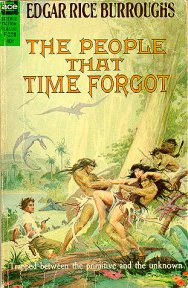 Moving
on to the second novella that forms the middle part of ERB's Caspak trilogy,
The
People That Time Forgot (TPTTF), I will endeavor to not repeat
comments from "TLTTF." However, I will be expanding on some of the
earlier revelations as more information becomes available.
Moving
on to the second novella that forms the middle part of ERB's Caspak trilogy,
The
People That Time Forgot (TPTTF), I will endeavor to not repeat
comments from "TLTTF." However, I will be expanding on some of the
earlier revelations as more information becomes available.
Again, reading my small Ace format for this re-read, I am immediately
struck once again by the cover art of Roy Krenkel, Jr. In a scene that
could have been ripped right out of Pellucidar, we see Thomas Billings
coming to the aid of the Galu Ajor as Bo-lu attempt to kidnap her to satiate
their brutish lust. The jungles, cliffs and pterodactyls provide a vivid
and primitive background with green the dominant color. Oh, yes, for the
first time I discern a T-Tex approaching the river with two or three animals
(possibly small horses), looking on from across a clearing.
The back cover shows the two pterodactyls from the front plus the following
blurb:
As before, Krenkel graces the reader with an interior illustration
on the title page. Though it's a bit murky, I was gratified to see a T-Rex
attacking a diplodocus, while the inevitable pterodactyl hovers above and
a cave-man, or maybe Billings, passes by the battle, very carefully!

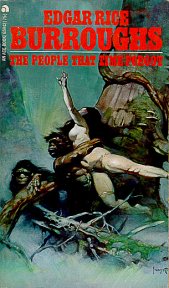
"TPTTP" was originally published in "Blue Book Magazine," in October
of 1918. This was two months after the initial installment of the Caspak
trilogy, or novel if you will.
As before, I also have a later printing, Ace as well. This time the
various printings are dated with mine being the seventh from June of 1979.
and again, as in The Land That Time Forgot, it is here in the later
printing that we discover the date of the original in small Ace format:
September of 1963.
The front cover is illustrated by Frank Frazetta, who is credited, unlike
the artist in the 1979 printing of "TLTTF." No credit was needed
as this cover is unmistakably in the Frazetta style. Here he depicts a
couple of lusty Alus who have captured a topless Ajor. All three are superbly
drawn. Not much in the way of background, but honestly, it's really not
necessary!
The back cover contains the following:
"RETURN TO THE DAWN OF TIME: When Tom Billings set out to
rescue Bowen Tyler from the lost continent of Caprona, he equipped himself
with all the weaponry the modern world afforded, and a light hydroplane
would allow him to scale the perilous wall of cliffs that surround the
island: Modern technology and American courage in a battle to the death
against dinosaurs, cave-tigers and savage submen--in Caspak, the land of
THE PEOPLE THAT TIME FORGOT."
Lin Carter's Foreword is again included and the page count runs from 124
to 153 in the Aces with 188 pages in the Bison. J. Allen St. John has two
of his original illustrations included in the latter format. The first
depicts Billings' battle with the pterodactyl. It is a fearsome monster
as shown by this brilliant artist! The second shows Ajor and Billings right
after he shot an attacking Alu. In my opinion, St John's Ajor pales in
comparison to Krenkel's and especially Frazetta's.
As gleaned from the Foreword and back cover blurbs, the discoverer of
Bowen Tyler's manuscript has brought it to the attention of Mr. Tyler,
Sr. in Santa Monica, who unfortunately dies while en route to meeting this
individual. Again, it probably is Burroughs himself. It is left to Tyler's
long-time friend, Thomas Billings, to arrange for the rescue of his old
college roommate. Traveling to Caprona upon the Tyler yacht Toreador, that
is soon initiated. Burroughs accompanies Billings and his crew. Thankfully,
only nine pages elapse before Caprona is sighted, as opposed to the 53
in "TLTTF." It is still unclear as to whether the large island is
in the extreme South Pacific Ocean or the outskirts of the Antarctic.
In true David Innes style, Billings enters Caspak much like Jason Gridley
did in Pellucidar. Both entered lost worlds in order to assist modern men
trapped therein. Both utilized airplanes and were downed by attacking pterodactyls.
Surviving his crash on the south eastern portion of Caspak, Billings
soon rescues the Galu princess Ajor an attacking prehistoric panther and
later, lustful Alus. So begins their journey north, from the land of the
Alus to those of the Galus. Bowen Tyler had undergone a similar journey
on the far side of the inland sea but had not reached Galu country, yet.
Speaking of Alus, it seems Burroughs changed his mind on this tribe,
between novellas. In "TLTTF" Alus included gorillas, anthropoid
apes and other stages of human evolution, culminating at the Neanderthal
level. One of the latter, Ahm, was very capable of speech though ERB did
refer to Alus as both Apemen and Speechless men. In The People That
Time Forgot, he makes a distinction between Apes and Apemen. The former
are now Ho-lus while the Alus (still no hyphen), are definitely called
Speechless men. In fact, the Bo-lus or Club-men are specified as the first
tribe to have true speech beyond gutter al growling.
Ajor is a very sexy woman, as Frazetta realizes and shows in his cover
art. After witnessing the shooting of the giant panther by Billings, she
seductively caresses the pistol barrel. At least that is my interpretation.
Of course, she may have been showing simple wonder at the strange weapon
that had just saved her.
As I said before, Ajor is a Galu princess, daughter of their chieftain,
Jor. More, she grew up in Galu country as one of the few babies born there,
to adulthood. The term for this is cos-ata-lo, meaning, a woman who was
born from sexual intercourse and did not evolve from the beginning, cor
sva jo. She informs Billings that the Wieroo from their island stronghold
of Oo-oh in the northern inland sea, often raid the Galus for women who
were born, in hopes of promoting their own reproductive capabilities. Even
some women who came up from the beginning are taken.
For those beings that make the journey from Ho-lu to Galu, the timeline
is approximately 700 years. We also learn in "TPTTF" that the period
of transition between tribes is fraught with danger. The individual must
vacate his old tribe before they see him or her because they will instinctively
know he is no longer of them. Also, if they are caught by either the old
or soon to be tribe in the no man's land between, they will be killed.
One must make it to the next tribe and present themselves to the chieftain,
before acceptance is readily given. That period of transition is known
as coslupak.
When a person moves on, they change their name but that custom seems
vague and perhaps untrue at times. Witness the case of To-mar and So-al.
They have been mated throughout their rise from the Ho-lus to the Kro-lus
and no indication of name changing is revealed.
As the evolution continues northward, the number of tribesmen diminishes
as the climate cools due to the increase in elevation. Plus, not all individuals
complete the process. Aside from violent deaths, some don't finish because
they are destined to rise only so far. The term in Caspak is batu, meaning
finished or done for.
The ultimate secret of Caspak has yet to be revealed, especially as
to how it all begins. Perhaps the immersion of the females in the slimy
pools plays a role... We'll see.
Some further information of interest is given out concerning some of
Caspak's tribes. The Band-lu may well practice cannibalism and they are
considered equivalent to the Cro-Magnon Man.
There are distinctions made as whether or not the various tribes are
of the east or west coast. Differences between the Kro-lus of each coast
exist and it is doubtful that they are aware of each others existence.
A tribe would have to build a boat and brave the terrors of the inland
sea, its reptilian inhabitants and the Weiroos themselves. I just don't
see that happening! Yet, a few chapters later, Chal-az declares that Al-tan
is chief of the Kro-lu of the east. Go figure. The Galus have the further
distinction of gaining new members from both coasts as the Kro-lus converge
in northeast Caspak. And they have a religion, worshipping one Luata. But
perhaps so too do the Kru-lus as Chal-az states "We will rise as Luata
has ordained that we shall rise, and only thus."
While the Kro-lus have domesticated wild dogs that guard the tribe's
herd of cows and live in an actual town, the Galus dwell in a city and
work with metal, including gold.
As far as meeting new animals not yet experienced in "TLTTF,"
we can add the afore-mentioned diplodocus and giant panther plus a wooly
rhino and mastodon. Hmmm. Perhaps the illustrations I thought were mammoths
are in fact mastodons. Never could tell the difference...
The big plot near the book's end is for a gang of renegade and newly
arrived Kro-lus to join with an equally rascally bunch of Galus who wish
to take over their city. This pits Ajor's father, Jor, against the rebel
Du-seen who has lusted after Ajor throughout the story. Just when it looks
like curtains for Thomas Billings, Ajor and Nobs (yes, Nobs!), they are
rescued from the evil alliance by the timely arrival of a thousand loyal
Galus, Bowen Tyler and most of the crew from the Toreador. For in a truly
heroic feat, they had scaled the barrier cliffs of Caprona and entered
Caspak proper. Tyler and the former Lys La Rue had naturally gravitated
to the Galu city rather than dwell in the caves from where they had thrown
the thermos bottle in their desperate bid for succor.
With Bradley given up for loss, the Americans begin their trek back
to their yacht, but not before Billings bids them farewell. He just couldn't
leave Ajor whom he loved deeply. I was minded of the Red Flower of Zoram
deciding to leave Pellucidar with Gridley, the man she loved.
Bowen doesn't even try to convince Billings, his old friend, to accompany
the party as they start to leave Caspak and as they disappear into the
forest, he and Ajor kiss and are content.
The third and last installment in The Land That Time Forgot trilogy
is Out of Time's Abyss. I find it curious that Edgar Rice Burroughs
did not continue to use "That Time Forgot" in the title. Still, it works
marvelously and at least "Time" itself appears in all three.
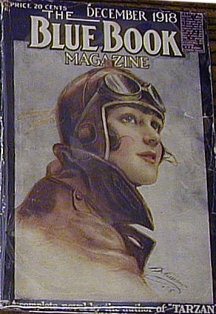 This
novella originally appeared, like its two predecessors, in "Blue Book Magazine"
in December of 1918. The same magazine and year but different months: August,
October and December. I would assume that all three were written in one
stretch, forming the single book they were meant to be. Curiously, the
1979 Ace printing does not give any of the other printing dates, including
the small Ace. The first two novelettes from 1979 had done so while the
small Aces only referenced the original "Blue Book Magazine" publication
dates.
This
novella originally appeared, like its two predecessors, in "Blue Book Magazine"
in December of 1918. The same magazine and year but different months: August,
October and December. I would assume that all three were written in one
stretch, forming the single book they were meant to be. Curiously, the
1979 Ace printing does not give any of the other printing dates, including
the small Ace. The first two novelettes from 1979 had done so while the
small Aces only referenced the original "Blue Book Magazine" publication
dates.
Looking at the prices of all three small Aces, I see that I must have
purchased the books in different years as they start at forty cents, rise
to fifty, and finish at sixty cents.
As before, it was the small Ace that I used in this re-read of Out
of Time's Abyss (OOTA). I have been sentimentally attached to
this format for all of the applicable series and stand-alones (Pellucidar,
Venus, the Moon, Barsoom, Cave Girl, Lost Continent, etc.), by Burroughs
and other authors as well. Otis
Adelbert Kline with his Mars and Venus books come readily to mind.
And there are many more... Many of these books by ERB are listed on the
back pages of these books and I joy in looking over these incredible titles
that have brought so much pleasure to me over the decades.
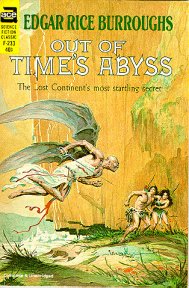 Once
more, Roy Krenkel illustrates the cover for "OOTA" and this may
be his best yet for Caspak! An incredibly detailed Wieroo hurtles toward
Bradley and Co-tan as their time in relative paradise comes to an end.
A cliff towers over all three while the City of the Human Skulls, threatens
in the background. The title page contains an illustration of the T. Rex
attacking Bradley's crew, which results in the first of several tragedy's
for that group.
Once
more, Roy Krenkel illustrates the cover for "OOTA" and this may
be his best yet for Caspak! An incredibly detailed Wieroo hurtles toward
Bradley and Co-tan as their time in relative paradise comes to an end.
A cliff towers over all three while the City of the Human Skulls, threatens
in the background. The title page contains an illustration of the T. Rex
attacking Bradley's crew, which results in the first of several tragedy's
for that group.
Continuing my recitations of back cover blurbs, here is what excited
me the first time I held the book in my trembling hands:
"On Caprona, the Land That Time Forgot, all of the world's savage
past still lived. Here were dinosaurs and flying reptiles, here were the
most primitive of cavemen and the last of the Bronze Age barbarians. But
there was one more secret that the claws and fangs and sharp-edged spears
guarded most of all."
"This is the story of the man who tried to find that final secret.
When Bradley, the adventurer, dared to cross the last terrible barrier
to the heart of Caprona, he entered a world of wonder, terror and danger
beyond the imagination of any man--except the imagination of Edgar Rice
Burroughs, author of OUT OF TIME'S ABYSS."
And again, I'm including the Lin Carter Foreword. But I'm going to
put in bold, a few phrases that make we wonder of Carter fully understood
events within "OOTA."
"Young traveler and adventurer Bowen Tyler has been marooned with
his wife on Caspak, a mysterious and uncharted land far in the southern
seas. Here Time's laws have been reversed, and the denizens of a thousand
lost ages struggle for supremacy. Amidst these terrors, Bowen Tyler seeks
to find and rescue his lovely wife."
"By an uncanny stroke of luck, Tyler has contacted the outside world.
To his aid came Tom Billings in a powerful seaplane, flying over the unscalable
cliffs that wall Caspak from the world. But the tropic jungles of this
weird valley are alive with a thousand dangers, and Billings, too, has
become lost, leaving his associates, Bradley and the others, behind at
the hastily-constructed "Fort Dinosaur" to await his return with Bowen
Tyler."
"Bradley refuses to wait any longer. He decides to set out with his
crew of rugged seamen and find the lost adventurers on his own. In this
savage land of primeval monsters, death awaits the unwary traveler in a
thousand horrible forms, and he fears that Billings may have fallen before
one of the savage reptiles, or even more savage ape-men."
"This is one of Edgar Rice Burroughs' most exciting adventure novels.
It was originally published as a sequel to his The People That Time Forgot,
but unlike most sequels, it can be completely enjoyed on its own, without
one's having read the previous novel. In Caspak, the strange land where
Time stood still, Burroughs made one of his most imaginative creations
and wrote an unforgettable story of thrilling adventure."
--Lin Carter
Science fiction critic
and editor of Spectrum
"Amidst these terrors, Bowen Tyler seeks to find and rescue his lovely
wife." I could be nit-picking here but this is old news by the time the
reader begins Out of Time's Abyss. Tyler has already found Miss
La Rue who then becomes his wife. But then, though Billings is aware of
this situation via the manuscript in the thermos bottle, Bradley is not.
"To his aid came Tom Billings in a powerful seaplane, flying over the
unscalable cliffs that wall Caspak from the world." Again, I may be too
picky. Probably am. Those unscalable cliffs were scaled by the crew of
the Toreador, albeit, with great difficulty. But it's true, when Billings
flew over them, the cliffs were previously unsalable. I may take this one
back.
"Billings, too, has become lost, leaving his associates, Bradley and
the others, behind at the hastily-constructed "Fort Dinosaur" to await
his return with Bowen Tyler." I'm a bit confused by this. Yes, Billings
does become lost but Bradley is not an associate of his. Nor are the remainder
of Tyler's group left at Fort Dinosaur. No one from the fort is even aware
of Billings' presence in Caspak and they are certainly not awaiting his
return with Bowen Tyler.
"Bradley refuses to wait any longer. He decides to set out with his
crew of rugged seamen and find the lost adventurers on his own. He fears
that Billings may have fallen." Bradley does not set out to look for Tyler.
He leaves Fort Dinosaur before Tyler does, on an exploration trip to the
north. It is Tyler who initially set out to find Bradley! Again, Bradley
has no idea of Billings' existence or entry into Caspak.
It was originally published as a sequel to his The People That Time
Forgot. Carter could have easily mentioned The Land That Time Forgot
as well and tied in all three installments of the trilogy. Not a mistake
per se, but a sin of omission.
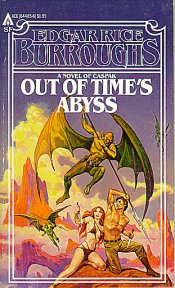 Concerning
the 1979 Ace printing, we are faced once more with a pretty good cover
by Vicente Segrelles though again the credit goes to Edgar Rice Burroughs,
Inc. Three Wieroo are depicted attacking Bradley and Co-tan, with an interesting
hill and stone arch in the background. Co-tan seems pleased to be helping
to ward off the Wieroos and her body is shown to best advantage. I suppose
too, that some women might find Bradley's build to be of interest...
Concerning
the 1979 Ace printing, we are faced once more with a pretty good cover
by Vicente Segrelles though again the credit goes to Edgar Rice Burroughs,
Inc. Three Wieroo are depicted attacking Bradley and Co-tan, with an interesting
hill and stone arch in the background. Co-tan seems pleased to be helping
to ward off the Wieroos and her body is shown to best advantage. I suppose
too, that some women might find Bradley's build to be of interest...
The back cover is adorned thusly:
"THE SECRET OF CASPAK: The jungle valley of the lost continent
of Caprona is a savage nest of giant reptiles, fierce cave-tigers, and
subhuman ape-men--but at its heart lurks a species of monsters so truly
horrible that it can only be likened to death itself."
"Into this fearful jungle walks Bradley, with a troop of fellow-adventurers,
intent on finding the lost aviator, Tom Billings. What they discover there
is an adventure almost beyond belief, as they find the secret of what truly
comes OUT OF TIME'S ABYSS."
"...intent on finding the lost aviator, Tom Billings." What, again? Maybe
I'm missing something here that my re-read to come will explain. To the
best of my knowledge, Bradley does not know of Billings until the conclusion
of "OOTA." But of course, the reverse is true, due to Tyler's
manuscript.
"... fierce cave-tigers," I am familiar with cave-lions, cave-bears,
giant panthers and saber-tooth tigers, but not cave-tigers. I suppose the
latter could indeed dwell in caves, like their cousins the cave-lions,
but I don't recall the term. Too bad Burroughs never detailed (in Caspak),
a battle between these two giant cats!
The page count for my three editions is as follows: small Ace: 125 pages,
1979 Ace: 139 pages and Bison: 137 pages. Speaking of the Bison Books edition
out of Nebraska Press, there are six pages of glossary appended to the
end of the book. Scott Tracy Griffin has compiled an in depth collection
of all the Caspakian words, peoples and tribes, geography and the cast
of characters from all three novellas. I am privileged to have met
Tracy at the Dum-Dum in Baltimore and my respect for him as a Burroughs
scholar is exemplified by his fantastic glossary!
Out of Time's Abyss begins in a pleasing manner. We are right
smack dab in the middle of Caspak from the get-go, until the penultimate
page. Bradley has just left Fort Dinosaur with Sinclair, Brady, James and
Tippet. The date was September 4, 1916. Left behind were Bowen Tyler, Ms.
La Rue, the remainder of the English tug crew and the Germans.
Almost immediately Tippet courageously saves Bradley from the deadly
charge of a cave-bear but as noted in "TPTTF," he was killed by
a tyrannosaurus and shortly after, so too was James, but by a saber-tooth.
The extraction of Tippet's body from the jaws of the T. Rex must have been
disgusting as the monster had already started to chew the sailor before
it finally died. Caspak is not gentle. We do learn it was Sinclair who
wrote the marker over Tippet's grave, discovered later by Bowen Tyler.
This marks the first official appearance of a tyrannosaurus in the Caspak
saga. Dire wolves and a cave bear add impressively to those prehistoric
beasts already tallied in the first two installments. Bradley at one point
comments on the numerous cave-lions, saber-tooth tigers and cave-bears
found in the northern reaches of the island. I got this Oz-type of feeling
as I read that.
I am somewhat amused by the various terms used by Tyler, Billings, Bradley,
Carter and back cover blurbers on describing what kind of land mass Caspak
is. I've seen island, continent, valley, crater and land. We know that
Caprona is too small to be a continent and it surely is an island. It's
also a crater containing the land of Caspak. It might be a bit of
a stretch to call it a valley, but not too much. Bradley estimates that
T. Tex lived about six million years ago and that therefore, Caspak has
stood unchanged for at least that long. If Burroughs only knew the truth
about the Age of Reptiles...
During their trek through the jungles and along the western barrier
cliffs, at least one Wieroo has been following and trying to abduct one
of their number. Each time it was driven off by gun fire with their piercing
wails echoing back to the prospective victims. Both Tippet and James became
convinced that death was beckoning and basically considered themselves
walking dead men. Despite my irritation at their superstition, I wonder
if they had the right of it?
Within a day's march of Fort Dinosaur, on their return march, Bradley
is taken by two Wieroos and presumed dead. He fell for the old distract
from one side and hit 'em from the blind. Sinclair and Brady flee back
to Fort Dinosaur in dismay where they rejoin Olson, Whitely and Wilson.
The remaining defenders fill in the exhausted returnees about Tyler's search
for Miss La Rue and the treachery and departure of Baron von Schoenvorts
and his German crew.
Bradley is "flown" by Fosh-bal-soj and his fellow Wieroo to their island
stronghold of Oo-oh on the inland sea. They land in the City of Human Skulls
on the western end of the 30 mile by 10 mile island. Two other unnamed
cities are situated on the far side and take no part in Bradley's tale.
While en route, he overheats the two Wieroos talking and understands them.
I don't recall his learning the Caspakian speech from Ahm as Tyler and
Miss La Rue had. And speaking of Ahm, he has been upgraded to a Bo-lu from
an Alu as related in "TLTTF." While this change is an inconsistency
it actually makes more sense this way. Neanderthals are a higher level
of human evolution than Apemen. And speaking of Apes, they are no longer
called Ho-lus as in "TPTTF." Anthropoid Apes and baboons are mentioned,
but not the gorillas from "TLTTF."
In what I consider a rather bizarre moment in the Caspak trilogy, Bradley
enters a Wieroo cafe, unescorted by Fosh-bal-soj. It is almost surrealistic
to imagine Bradley sitting on his stool at a counter and eating his bowl
of stew as nearby Wieroos glare at him. When called upon to sign for his
meal, Bradley freaks out the proprietor by writing his full signature instead
of placing his mark, as expected. I guess the Galus can build and maintain
a decent city but can't write...
Shortly after leaving the cafe, Bradley is accosted by the Wieroos who
had been inside. No fighting allowed in eating establishments. He fights
them off but then must kill Fos-bal-soj when he tries to punish Bradley
for daring to strike even the lowliest of Wieroos. Relative freedom is
short lived and Bradley is recaptured and thrown into a dungeon with An-tak
who turns out to be the brother of Co-tan. He is almost totally mad and
quite starved. The Wieroo only give him water and he lives on rats and
lizards. But both have become wary of late... With what may have been An-tak's
last words providing a valuable, clue, Bradley escapes his cell and travels
to the Wieroo palace by pretending to be a dead Wieroo floating down the
river to the sea. It works every time! In the palace, he rescues the Galu
beauty Co-tan who had been kidnapped by the Wieroos for breeding purposes.
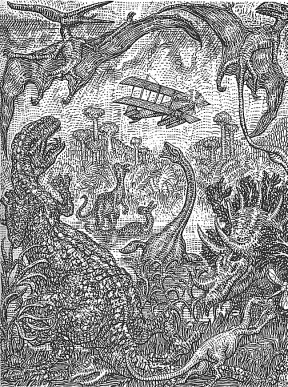 Between
An-tak and Co-tan, Bradley pieces together the history of the Wieroo. Untold
eons ago, they were Galus but of different villages, in rivalry with the
present Galu city of Zor. They were the first to develop cos-ata-lu but
their problem was that when children were born from the womb (cos-ata-lu),
only males were produced. These Galus warred upon the other Galus and even
Kro-lu for woman to be used for breeding. Being first to evolve to this
level, these Galus felt superior and their minds developed attributes that
led to tas-ad, where things had to be done the Wieroo way, the right way.
No opposition to this concept was allowed and repressed brutally when it
appeared.
Between
An-tak and Co-tan, Bradley pieces together the history of the Wieroo. Untold
eons ago, they were Galus but of different villages, in rivalry with the
present Galu city of Zor. They were the first to develop cos-ata-lu but
their problem was that when children were born from the womb (cos-ata-lu),
only males were produced. These Galus warred upon the other Galus and even
Kro-lu for woman to be used for breeding. Being first to evolve to this
level, these Galus felt superior and their minds developed attributes that
led to tas-ad, where things had to be done the Wieroo way, the right way.
No opposition to this concept was allowed and repressed brutally when it
appeared.
According to Galu legends, these ancestors of the Wieroo possessed rudimentary
wings. Why this was is unknown and frankly, makes little sense. The Galus
started breeding for better developed wings until eventually, the race
became truly to possess functional wings. This allowed the Wieroos to attempt
to bring tas-ad to all of Caspak. These attacks caused most of the human
tribes to unite for the only time in the entire existence of Caspak, resulting
in defeat for the Wieroos and forcing their flight from Galu country to
the island of Oo-oh on the inland sea. Here they licked their wounds and
built three cities. It is not stated but I suspect that each city is independent
of one another. Since that war in Caspak's dim past, the Wieroos have continued
to raid the Galus for women, ignoring the lesser tribes. Without these
breeding females, the race would eventually die out as no new members come
up cor-sva-jo, from the beginning. The current Galus are blessed by new
additions from each coast and some new born.
I'm not sure if the Wieroo method of climbing the hierarchical ladder
is practical. Murders are encouraged and when a certain number of these
are accomplished and confessed to the leader, "He Who Speaks For Luata,"
they are rewarded by a colored slash on their white robes. When enough
slashes fill a robe with a color, a new white one is issued and a new and
higher color is slashed. Blue is the ultimate color and only "He Who Speaks
For Luata" is privileged to be adorned thus. Just imagine the ferocity,
depravity and cruelty of such a creature!
An interesting aside to this rise to power is that it is against the
Wieroo law to slay someone of an all red robe. Those that do have their
wings severed and then their heads before being tossed into the River of
Death. So I wonder how one obtains blue slashes...
Bradley and Co-tan escape the City of Human Skulls and dwell in their
private paradise for a few weeks. Though still on the island of Oh-oo,
they finally get to enjoy each others company, resulting in their fallin
head over heels in love. I am minded of a similar time that David Innes
and Diane the Beautiful spent in Pellucidar. Finally, the day comes as
they knew it must, and they are discovered by a Wieroo scout. However,
when a patrol is sent to recapture them, Bradley and Co-tan kill all but
two and these are forced to fly the two to the western coast of the mainland.
The Wieroos are spared in return for their taxi service.
The two start trekking south through the Kro-lu country to that of the
Bo-lus, in an attempt to reach Fort Dinosaur. This they do and discover
that the Germans had been forced to return to Caspak in the submarine and
have ambushed and enslaved the surviving Englishmen. Bradley and Co-tan
rectify this situation, resulting in the deaths of Von Schoenverts and
his officers, Schwartz and Dietz.
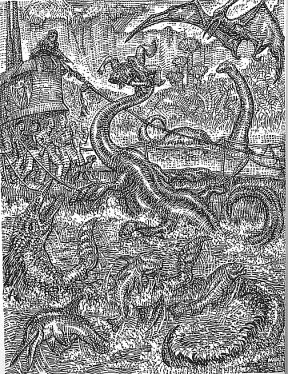 Seizing
control of the U-boat, the combined parties sail north along the coast
of the inland sea, searching for Bowen Tyler and Lyss La Rue. Soon after
reaching Galu country, they espy a party of Galus, among whom is Tan, Co-Tan's
father. To sweeten this reunion, both Tom Billings and Ajor arrive. Bradley
never divulges the fate (starvation and mental degradation), of An-tak
to Co-tan, even after discovering they are brother and sister. Perhaps
he does after they leave Caprona. Bradley learns from Billings that Bowen
Tyler and Miss La Rue had been found and were en-route back to the Toreador.
As happy endings go, this one is pretty complete. All three couples from
each novella, end up on the yacht and are married by the ship's captain
before returning to Santa Monica where they soon go their separate ways.
I do hope that they still kept in touch as they all shared similar and
extraordinary adventures in Caspak, the Land That Time Forgot.
Seizing
control of the U-boat, the combined parties sail north along the coast
of the inland sea, searching for Bowen Tyler and Lyss La Rue. Soon after
reaching Galu country, they espy a party of Galus, among whom is Tan, Co-Tan's
father. To sweeten this reunion, both Tom Billings and Ajor arrive. Bradley
never divulges the fate (starvation and mental degradation), of An-tak
to Co-tan, even after discovering they are brother and sister. Perhaps
he does after they leave Caprona. Bradley learns from Billings that Bowen
Tyler and Miss La Rue had been found and were en-route back to the Toreador.
As happy endings go, this one is pretty complete. All three couples from
each novella, end up on the yacht and are married by the ship's captain
before returning to Santa Monica where they soon go their separate ways.
I do hope that they still kept in touch as they all shared similar and
extraordinary adventures in Caspak, the Land That Time Forgot.
Back in 2000, I had noted a couple of typos in the small Ace editions.
I'm happy to report that they were corrected by 1979. "Noting" on page
38 becomes "nothing" on page 43 while "they" on page 91 becomes "the" on
page 101. There may well have been others but these two were the only ones
I caught.
A satisfying finish to my review of all three Caspaks novellas would
be to finish relating the evolutionary secrets of that island. We are already
aware of the two ways of attaining Galu status: cos-ata-lu (lo), man or
woman born from the womb and cor-sva-jo, from the beginning. But what is
the beginning and how does the evolutionary process start there? We already
know that the females of all the human tribes, immerse themselves for at
least an hour a day in the warm stagnant pools near their respective dwellings.
No predators of any sort inhabit these pools. Here they deposit their eggs
or ovum which are somehow, I don't know how, fertilized and prepared for
their journey out of the pools, down the exiting stream to the inland sea.
Initially, some of these eggs quickly develop into tadpoles, others not
until the streams or the inland sea and are coated with a toxin that protects
them from attack until soon after the sea is reached. Then, they are on
their own as they travel south to the beginning.
These tadpoles evolve into fishes, then reptiles and amphibians, until
they climb out onto land at the southern shore of Caspak's inner sea. It
should be noted that some forms only reach a certain stage and stop evolving.
It could occur at any stage and fate alone decides how high up the evolutionary
scale one can attain.
One of the confusing aspects of evolution on Caspak is that the amphibians
evolve next into mammals, including primates: monkeys, baboons and apes,
the Ho-lus. This seems dubious at best but so it is explained. I assume
that the dinosaurs and savage (and not so savage) mammals are a part of
the evolutionary equation...
In order for a Galu woman to be able to give birth, "seven generations
of the same ancestor must come up from the beginning. Seven cycles it requires
before the seventh Galu can complete the seventh danger-infested cycle
since its first Galu ancestor achieved the state of Galu. For ages before,
the ancestors of this first Galu may have developed from a Band-lu or Bo-lu
egg without ever once completing the whole circle--that is from a Galu
egg, back to a fully developed Galu." This takes approximately 700 years.
My interpretation of this and I admit to being only vaguely aware of
what Burroughs was trying to promulgate, is that a Galu woman releases
a fertilized egg that very luckily completes the rise from the beginning
to Galu. That Galu in turn performs the same task and so on until it has
occurred seven times. Then and only then, can a Galu woman give birth.
I do wonder how long the Galus live once that stature is obtained since
it took 700 years of human evolution to get there? Even those that are
fated to stop at the Bo-lu, Kro-lu or any level of humanity, I wonder at
their life span. Another thought, if women don't give birth in Caspak,
excepting some of the Galus, do the men and women from the Kro-lu down
feel the sexual urge to copulate? Do the savage beasts of Caspak feel this
also or do only newer forms rise from the beginning to replace those that
die or evolve?
Regardless of the answers to these questions, indeed, should such answers
exist at all, I found the adventures of Bowen Tyler, Tom Billings and Bradley
(is his first name ever given?), to be top notch and Edgar Rice Burroughs
was absolutely at the top of his game when he wrote these three interconnected
novellas or if you will, this one novel. In fact, I'm so satisfied from
this latest re-read that I feel the urge to re-read the Caspak fan fiction
that has been submitted in recent years...
Steve S. ~ February 2008
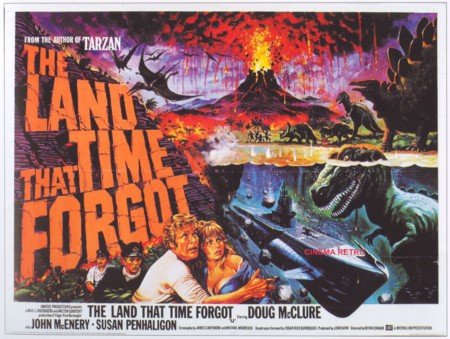

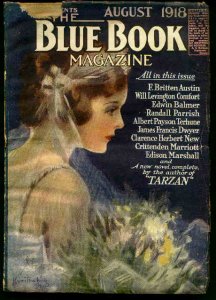
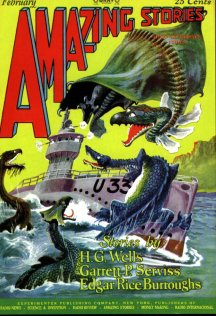
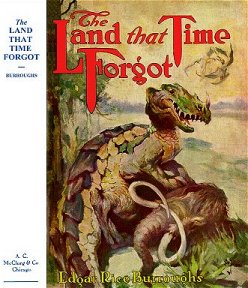
 Roy
Krenkel, Jr. illustrates all three covers of the early Ace editions and
all are marvelous. The Land That Time Forgot features no scene from
the book but does capture the primitive and exotic atmosphere of Caspak.
We see a saber-tooth tiger crouched over and protecting its recent kill,
a baby mammoth. Its mother can be seen looking on helplessly in the background.
Behind the big cat, a T-Rex and allosaurus battle as two primitive warriors
scurry out of their way. A couple of pterodactyls soar above the nearby
jungle while mysterious hills rear up in the distance. This may well be
one of Krenkel's best covers of an Edgar Rice Burroughs book!
Roy
Krenkel, Jr. illustrates all three covers of the early Ace editions and
all are marvelous. The Land That Time Forgot features no scene from
the book but does capture the primitive and exotic atmosphere of Caspak.
We see a saber-tooth tiger crouched over and protecting its recent kill,
a baby mammoth. Its mother can be seen looking on helplessly in the background.
Behind the big cat, a T-Rex and allosaurus battle as two primitive warriors
scurry out of their way. A couple of pterodactyls soar above the nearby
jungle while mysterious hills rear up in the distance. This may well be
one of Krenkel's best covers of an Edgar Rice Burroughs book!
 I
also possess a later edition of this book, by Ace as well. This version
was published in 1979, according to the cover art copyright. It also gives
the original Ace printing date of August 1970, not given in that small
Ace format. This version is in the traditional mass market paperback style,
with (surprisingly), 153 pages compared to 126. The aforementioned cover
art depicts a similar scene that Krenkel illustrates in his frontispiece.
The artist (Vicente Segrelles) is not credited, that going to Edgar Rice
Burroughs, Inc. Too bad as it is very well drawn, though in a crisper style
than Krenkel. As I look at it now, I believe I was in error by stating
that the scene depicted by Krenkel was on the U-33's approach to Caprona.
It could very well be taken from the submarine's journey up the river,
with the soaring cliffs viewed from inside Caspak.
I
also possess a later edition of this book, by Ace as well. This version
was published in 1979, according to the cover art copyright. It also gives
the original Ace printing date of August 1970, not given in that small
Ace format. This version is in the traditional mass market paperback style,
with (surprisingly), 153 pages compared to 126. The aforementioned cover
art depicts a similar scene that Krenkel illustrates in his frontispiece.
The artist (Vicente Segrelles) is not credited, that going to Edgar Rice
Burroughs, Inc. Too bad as it is very well drawn, though in a crisper style
than Krenkel. As I look at it now, I believe I was in error by stating
that the scene depicted by Krenkel was on the U-33's approach to Caprona.
It could very well be taken from the submarine's journey up the river,
with the soaring cliffs viewed from inside Caspak.
 Moving
on to the second novella that forms the middle part of ERB's Caspak trilogy,
The
People That Time Forgot (TPTTF), I will endeavor to not repeat
comments from "TLTTF." However, I will be expanding on some of the
earlier revelations as more information becomes available.
Moving
on to the second novella that forms the middle part of ERB's Caspak trilogy,
The
People That Time Forgot (TPTTF), I will endeavor to not repeat
comments from "TLTTF." However, I will be expanding on some of the
earlier revelations as more information becomes available.


 This
novella originally appeared, like its two predecessors, in "Blue Book Magazine"
in December of 1918. The same magazine and year but different months: August,
October and December. I would assume that all three were written in one
stretch, forming the single book they were meant to be. Curiously, the
1979 Ace printing does not give any of the other printing dates, including
the small Ace. The first two novelettes from 1979 had done so while the
small Aces only referenced the original "Blue Book Magazine" publication
dates.
This
novella originally appeared, like its two predecessors, in "Blue Book Magazine"
in December of 1918. The same magazine and year but different months: August,
October and December. I would assume that all three were written in one
stretch, forming the single book they were meant to be. Curiously, the
1979 Ace printing does not give any of the other printing dates, including
the small Ace. The first two novelettes from 1979 had done so while the
small Aces only referenced the original "Blue Book Magazine" publication
dates.
 Once
more, Roy Krenkel illustrates the cover for "OOTA" and this may
be his best yet for Caspak! An incredibly detailed Wieroo hurtles toward
Bradley and Co-tan as their time in relative paradise comes to an end.
A cliff towers over all three while the City of the Human Skulls, threatens
in the background. The title page contains an illustration of the T. Rex
attacking Bradley's crew, which results in the first of several tragedy's
for that group.
Once
more, Roy Krenkel illustrates the cover for "OOTA" and this may
be his best yet for Caspak! An incredibly detailed Wieroo hurtles toward
Bradley and Co-tan as their time in relative paradise comes to an end.
A cliff towers over all three while the City of the Human Skulls, threatens
in the background. The title page contains an illustration of the T. Rex
attacking Bradley's crew, which results in the first of several tragedy's
for that group.
 Concerning
the 1979 Ace printing, we are faced once more with a pretty good cover
by Vicente Segrelles though again the credit goes to Edgar Rice Burroughs,
Inc. Three Wieroo are depicted attacking Bradley and Co-tan, with an interesting
hill and stone arch in the background. Co-tan seems pleased to be helping
to ward off the Wieroos and her body is shown to best advantage. I suppose
too, that some women might find Bradley's build to be of interest...
Concerning
the 1979 Ace printing, we are faced once more with a pretty good cover
by Vicente Segrelles though again the credit goes to Edgar Rice Burroughs,
Inc. Three Wieroo are depicted attacking Bradley and Co-tan, with an interesting
hill and stone arch in the background. Co-tan seems pleased to be helping
to ward off the Wieroos and her body is shown to best advantage. I suppose
too, that some women might find Bradley's build to be of interest...
 Between
An-tak and Co-tan, Bradley pieces together the history of the Wieroo. Untold
eons ago, they were Galus but of different villages, in rivalry with the
present Galu city of Zor. They were the first to develop cos-ata-lu but
their problem was that when children were born from the womb (cos-ata-lu),
only males were produced. These Galus warred upon the other Galus and even
Kro-lu for woman to be used for breeding. Being first to evolve to this
level, these Galus felt superior and their minds developed attributes that
led to tas-ad, where things had to be done the Wieroo way, the right way.
No opposition to this concept was allowed and repressed brutally when it
appeared.
Between
An-tak and Co-tan, Bradley pieces together the history of the Wieroo. Untold
eons ago, they were Galus but of different villages, in rivalry with the
present Galu city of Zor. They were the first to develop cos-ata-lu but
their problem was that when children were born from the womb (cos-ata-lu),
only males were produced. These Galus warred upon the other Galus and even
Kro-lu for woman to be used for breeding. Being first to evolve to this
level, these Galus felt superior and their minds developed attributes that
led to tas-ad, where things had to be done the Wieroo way, the right way.
No opposition to this concept was allowed and repressed brutally when it
appeared.
 Seizing
control of the U-boat, the combined parties sail north along the coast
of the inland sea, searching for Bowen Tyler and Lyss La Rue. Soon after
reaching Galu country, they espy a party of Galus, among whom is Tan, Co-Tan's
father. To sweeten this reunion, both Tom Billings and Ajor arrive. Bradley
never divulges the fate (starvation and mental degradation), of An-tak
to Co-tan, even after discovering they are brother and sister. Perhaps
he does after they leave Caprona. Bradley learns from Billings that Bowen
Tyler and Miss La Rue had been found and were en-route back to the Toreador.
As happy endings go, this one is pretty complete. All three couples from
each novella, end up on the yacht and are married by the ship's captain
before returning to Santa Monica where they soon go their separate ways.
I do hope that they still kept in touch as they all shared similar and
extraordinary adventures in Caspak, the Land That Time Forgot.
Seizing
control of the U-boat, the combined parties sail north along the coast
of the inland sea, searching for Bowen Tyler and Lyss La Rue. Soon after
reaching Galu country, they espy a party of Galus, among whom is Tan, Co-Tan's
father. To sweeten this reunion, both Tom Billings and Ajor arrive. Bradley
never divulges the fate (starvation and mental degradation), of An-tak
to Co-tan, even after discovering they are brother and sister. Perhaps
he does after they leave Caprona. Bradley learns from Billings that Bowen
Tyler and Miss La Rue had been found and were en-route back to the Toreador.
As happy endings go, this one is pretty complete. All three couples from
each novella, end up on the yacht and are married by the ship's captain
before returning to Santa Monica where they soon go their separate ways.
I do hope that they still kept in touch as they all shared similar and
extraordinary adventures in Caspak, the Land That Time Forgot.














